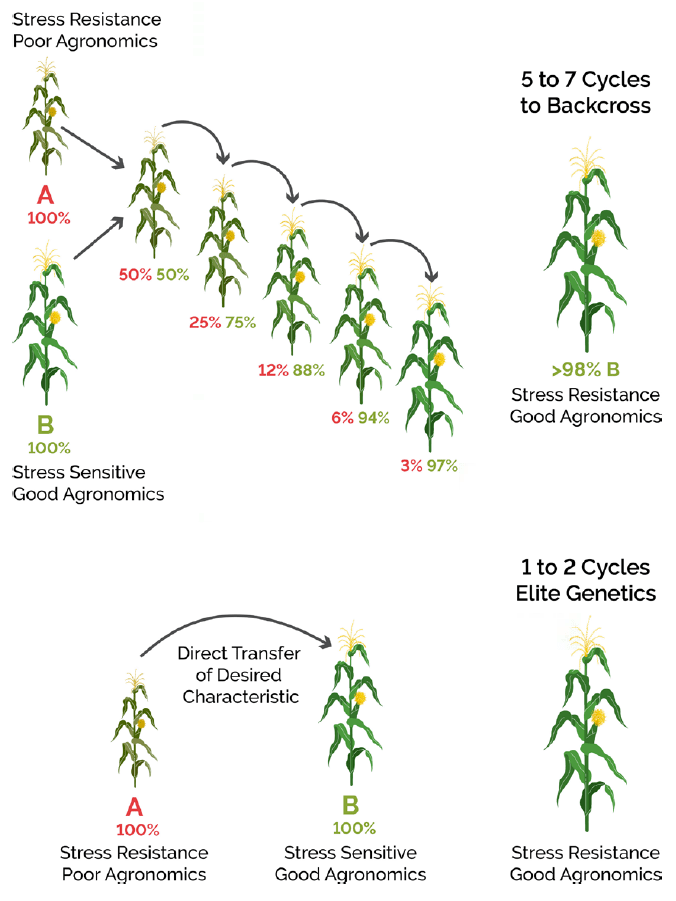CRISPR-Cas9 is making its way into the agricultural sector. Agricultural heavyweight DuPont Pioneer is clearly taking the lead in bringing the technology into plant breeding: about a year ago, the company announced that it would develop a new and improved waxy corn variety with CRISPR-Cas9. Is CRISPR the technology that will make genetic engineering for crops available globally?
Every now and then, a new technology shakes up the agricultural sector and changes the way new plant varieties are developed. All of these innovative methods, from marker- assisted breeding to the creation of hybrids to biotechnology and GMOs, have brought something new to the table in plant breeding. Now, after already making waves in the medical arena, the gene-editing technology CRISPR-Cas9 seems to be next in line to rejuvenate the breeding industry.
The efficiency catalyst
DuPont Pioneer, one of the world’s largest producers of seeds, is an early adopter of the technology for use in plants. We asked Neal Gutterson, Vice President of R&D at the company, about the state of CRISPR gene editing in plants.
“Without a doubt, this is another important tool for plant breeding,” comments Gutterson. “Rather than replacing conventional breeding techniques or biotechnology, it’s an important, new, distinct method for improving crops.

One of the key issues here is that we are editing genomes, not adding genetic material from other species. We work within the corn genome, for instance, only with corn genes and how they normally behave and perform. With CRISPR, we can make minor edits and deletions, all operating within the corn gene pool. By using CRISPR, we can bring our products to the market much more efficiently. We deliver the same outcomes as we do when using conventional or mutational breeding, but CRISPR makes the process so much faster and more targeted.”
Efficiency really is a huge advantage in the field of plant breeding. The traditional method of inserting a certain trait into a certain variety is very time consuming and requires a whole series of backcrosses. With waxy corn, for instance, making a deletion of the target gene in an elite variety is a tedious process. All of that can be reduced to a single step, thanks to CRISPR. The gain in efficiency becomes exponential when you consider multiple modified alleles!
Will they/won’t they?
Whether or not CRISPR technology will become a blockbuster success will depend a great deal on the position of the government. In general, there are two possible scenarios: either plant varieties developed with CRISPR will be tightly regulated and land in a GMO-like situation (from a regulatory standpoint), or they will be treated the same way as varieties developed with traditional breeding methods and will remain unregulated. Gutterson elaborates:
“We received notification from the US government that they would not regulate waxy corn, our first CRISPR-enabled product, so we now know how the stage is set in the US, and we can move forward with a clear framework in mind. In other places, this framework is still under discussion. Right now, governments around the world are asking themselves how they will treat products that come out of gene editing. However, given how long it will take before the first products reach the market, there’s plenty of time for regulators to understand the technology and make decisions.”
Regulation took its toll on the widespread application of GMOs, but since CRISPR has a very different story, the future of the technology looks bright.
“If the products developed with CRISPR are treated like the products of regular breeding, the opportunities will be broader,” explains Gutterson. “In this scenario, you might think of CRISPR technology as being inherently more democratic. More people around the world will be able to use this technology, if the cost of regulation is less of a concern. This broad applicability wasn’t really possible with GMOs, due to a number of issues, including the regulatory costs. If those issues aren’t relevant for CRISPR, I think we’ll see a much wider adoption of this tech in a broader set of crops than we saw for GMOs.”
Waxy corn: first in the CRISPR line
Last year, DuPont Pioneer announced its first product that would be developed with CRISPR technology: a new and improved waxy corn variety. Waxy corn has been around since the early twentieth century. While normal corn kernels contain 75% amylopectin and 25% amylose, a deletion in the waxy gene results in waxy corn kernels that contain over 97% amylopectin, essentially eliminating amylose from the kernel.
As Gutterson notes, “The starch isolated from waxy corn kernels has some unique applications in food and industry. It’s a modest market but an ideal one for introducing a new variety. The genetics are very straightforward, and the supply chain isn’t affected in any way. We can present our customers with an improved product—one that they’re familiar and comfortable with. That’s a nice starting point for an innovative technology; it lets us see how customers, regulators, and the public treat this kind of innovation.”
Just as it did in medicine, CRISPR is taking off in the agricultural sector at a dazzling speed. Of course, a ton of work needs to be done before anything can be commercialized. DuPont Pioneer’s VP names the end of the decade as a realistic goal.
“It’s still early days for CRISPR applications, but we’re moving pretty quickly,” comments Gutterson. “In the last year or two, we’ve begun to move from the establishment of the core technology to its practical application. We aim to launch the first CRISPR-enabled product around 2020.”


